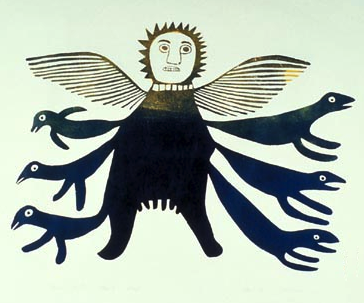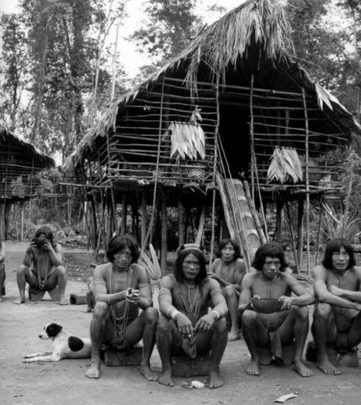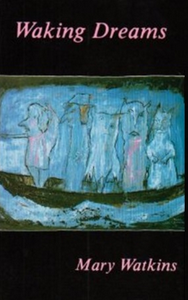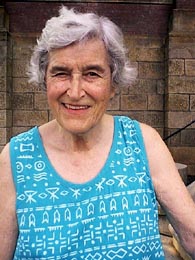The Reality of Spirits: A Tabooed or Permitted Field of Study
Home » Articles and News » The Reality of Spirits: A Tabooed or Permitted Field of Study
by Edith Turner
 In the past in anthropology, if a researcher “went native,” it doomed him academically. My husband, Victor Turner, and I had this dictum at the back of our minds when we spent two and a half years among the Ndembu of Zambia in the fifties.
In the past in anthropology, if a researcher “went native,” it doomed him academically. My husband, Victor Turner, and I had this dictum at the back of our minds when we spent two and a half years among the Ndembu of Zambia in the fifties.
All right, “our” people believed in spirits, but that was a matter of their different world, not ours. Their ideas were strange and a little disturbing. Yet somehow we were on the safe side of the White divide and were free merely to study the beliefs.
This is how we thought. Little knowing it, we denied the people’s equality with ours, their “coevalness,” their common humanity as that humanity extended itself into the spirit world.
Try out that spirit world ourselves? No way!
But at intervals, that world insisted it was really there. For instance, in the Chihamba ritual at the end of a period of ordeal, a strong wave of curative energy hit us. We had been participating as fully as we knew how, thus opening ourselves to whatever entities that were about. In another ritual, for fertility, the delight of dancing in the moonlight hit me vividly, and I began to learn something about the hypnotic effect of singing and hearing the drums.
Much later, Vic and I witnessed a curious event in New York City in 1980, while running a workshop at the New York University Department of Performance Studies, which was attended by performance and anthropology students. With the help of the participants, we were trying out rituals as actual performances with the intention of creating a new educational technique.
We enacted the Umbanda trance session, which we had observed and studied in one of the slums of Rio de Janeiro. The students duly followed our directions and also accompanied the rites with bongo drumming and songs addressed to the Yoruba gods. During the ritual, a female student actually went into a trance, right there in New York University. We brought her ’round with our African rattle, rather impressed with the way this ritual worked even out of context. The next day, the student told us that she had gone home that night and correctly predicted the score of a crucial football game, impressing us even further.
Since then, I have taken note of the effects of trance and discovered for myself the three now obvious regularities: frequent, nonempirical cures; clairvoyance, which includes finding lost people or objects, divination, prediction, or forms of wisdom speaking; and satisfaction or joy—these three effects repeating, almost like a covenant.
What spirit events took place in my own experience?
One of them happened like this. In 1985, I was due for a visit to Zambia. Before going, I decided to come closer than on previous occasions to the Africans’ own experience, whatever that was—I did not know what they experienced. So it eventuated, I did come closer.
My research was developing into the study of a twice-repeated healing ritual. To my surprise, the healing of the second patient culminated in my sighting a spirit form. In a book entitled Experiencing Ritual(1), I describe exactly how this curative ritual reached its climax, including how I myself was involved in it; how the traditional doctor bent down amid the singing and drumming to extract the harmful spirit; and how I saw with my own eyes a large, gray blob of something like plasma emerge from the sick woman’s back.
Then I knew the Africans were right. There is spirit stuff. There is spirit affliction; it is not a matter of metaphor and symbol, or even psychology. And I began to see how anthropologists have perpetuated an endless series of put-downs about the many spirit events in which they participated—”participated” in a kindly pretense. They might have obtained valuable material, but they have been operating with the wrong paradigm, that of the positivists’ denial.
To reach a peak experience in a ritual, sinking oneself fully in it really is necessary. Thus for me, “going native” achieved a breakthrough to an altogether different world view, foreign to academia, by means of which certain material was chronicled that could have been gathered in no other way.
On the subject of radical participation, Dan Rose predicted that:
…students will seek to place themselves in unfolding situations, to live through complex ongoing events…rather than looking alone for the meanings of gestures, the presentations of selves, class relations, the meaning of rituals, or other abstract, analytical category phenomena on which we historically have relied.
Jackson(2 )helps to make this point: “To break the habit of using a linear communicational model for understanding bodily praxis, it is necessary to adopt a methodological strategy of joining in without ulterior motive and literally putting oneself in the place of other persons: inhabiting their world [what was pejoratively labeled ‘going native’ in the early days of anthropology].”
Participation thus became an end in itself rather than a means of gathering closely observed data which will be subject to interpretation elsewhere after the event. (3)
 Later, in 1987, when I went to northern Alaska to conduct research on the healing methods of Inupiat Eskimos, I similarly found myself swamped with stories of strange events, miracles, rescues, healings by telephone hundreds of miles away, visions of God, and many other manifestations. It was by these things that the people lived. Their ears were pricked up for them, as it were. I spent a year in the village acting as a kind of pseudo auntie, listening to, and believing, the stories. And naturally, those things happened to me about as frequently as they did to them.
Later, in 1987, when I went to northern Alaska to conduct research on the healing methods of Inupiat Eskimos, I similarly found myself swamped with stories of strange events, miracles, rescues, healings by telephone hundreds of miles away, visions of God, and many other manifestations. It was by these things that the people lived. Their ears were pricked up for them, as it were. I spent a year in the village acting as a kind of pseudo auntie, listening to, and believing, the stories. And naturally, those things happened to me about as frequently as they did to them.
For instance, it happened that in July 1987, before I went to Alaska or knew the ecology at first hand, I attended Harner shaman workshop in Virginia. He was teaching the workshop participants how to make a shamanic journey while lying down in darkness. We were to visualize a climb upward, up a tree, or mountain, or building, or the like. After a first stage of visualization, the experience itself was liable to take over, and we would meet a “teacher” of some kind.
We lay down and Michael beat his drum steadily. I visualized my ascent and found myself out on a bank of cloud. “How corny,” I said. A figure appeared on my left, a monk in a cowl, and I again thought, “How corny, like a cartoon. ” I went up a little more and came to an entire wall of electronic appliances, VCRs, CD sets, stereos, radios, and a large TV screen toward the right. Pictured in the screen was something dark red, filling the whole rectangle. It looked like a maze of internal organs sideways-on, elongated, and definitely unlike human internal organs. Why were they there? What was that all about?
But I must not criticize, and when the drumming changed I went down the way I had come and eventually remembered that I was lying on the floor. The other participants were sitting up around me. We told our experiences to Harner; he accepted them but did not analyze them psychologically.
Four months later in November, when I was settled among the Eskimos at Point Hope, Alaska, sitting in Ernest Frankson’s house, Ernest pulled into the room the body of a ringed seal. His wife laid the seal on some cardboard and proceeded to take off the skin. She allowed me to help cut off the blubber. Then she made a slit down the stomach and displayed to view the internal organs. Wondering, I contemplated them carefully. It was striking to see the dark red parts, liver, spleen, intestines, lungs, heart, and so on, settled together, sliding together with such orderliness and easy movement.
Two days later I caught on, as my diary records. Those internal organs were the same organs that I had seen on the shaman TV screen in July.
Ernie caught himself a whale the following April. (I use the word “caught” in keeping with Eskimo etiquette toward the whale.) I was working for another whaling crew and was occupied with cooking for the men. We waited on the edge of the ice, but no whales came near. An English BBC man was staying in my house in the village, hoping to film the whale hunt. Ernie said, “The whales don’t like filming.” But what could I do, turn the BBC man out?
One day, while my crew and I were down on the ice, a dangerous wind came up, and we left in a hurry, observing widening cracks as we made for the beach. After that, no whaling was possible for two weeks. Finally, the BBC man was refused his request to film the whaling and left town. The minute he left, the wind changed back in our favor. All was well, and Ernie caught his whale, with our assistance.
Ernie simply said, “The whale can change the weather.” The whole village, including me, understood the matter in the same way.
Ernie often accused me of not believing in these manifestations, but I protested that I did. How could I help it? Ernie usually had a bad time from Whites, who labeled his experiences “magical beliefs.” But by then, I myself was within the circle of regular Eskimo society and experienced such events from time to time. I am now learning that studying such a mentality from inside is a legitimate and valuable kind of anthropology that is accessible if the anthropologist takes that “fatal” step toward “going native.”
Members of many different societies, even our own, tell us they have had experience of seeing or hearing spirits. Let us recall how anthropology has dealt with the question in the past.
Mainline anthropologists have studiedly ignored the central matter of this kind of information—central in the people’s own view—and only used the material as if it were metaphor or symbol, not reality, commenting that such and such “metaphor” is congruent with the function, structure, or psychological mind set of the society. Clearly, this is a laudable endeavor as far as it goes. But the neglect of the central material savors of our old bête noire, intellectual imperialism.
What is pitiful is the tendency of anthropologists from among the native peoples themselves to defer to the Western view and accordingly draw back from claiming the truth of their own religion. The mission of Western anthropologists to explain the system in positivist terms at all costs, which thereby influences a new elite, is oddly similar to the self-imposed task of the more hidebound religious missionaries who are also sworn to eliminate their hosts’ religion.(4)
So one asks, what are the ethics of this kind of analysis, this dissection? May we continue in this age of multi power and multi cultures to enter a foreign society, however politely, measure it up according to our own standards, and then come back home and dissect it in a way entirely estranged from the ethos of the people concerned?
We can see three such methods of dissection.
The first is illustrated by the anthropologist who goes out to examine a certain feature of the society, such as Richard Nelsons did when he studied the hunters of the northern ice at Wainwright, Alaska. He contrived to write an entire book from a positivist, practical standpoint, stating that no mystery cults of occult beliefs existed at the time of writing among these Eskimos. Nevertheless, my friend, Enoch Oktollik from Wainwright, has told me how he, Enoch, resents the imputations of the Whites and the way they have eroded Eskimo culture. His own mother has seen visions and predicted the coming of a whale. Nelson, though, has now changed his tack; he no longer thinks the Natives’ tales are magical rubbish.(5)
Then there are the anthropologists who say, “Wait a bit! We can see interesting structural regularities in this culture.” Levi Strauss led this fashion by writing of Aborigine totemism—those traditional ideas involving awe and respect for certain animals: “Totemism pertains to the understanding, and the demands to which it responds and the way in which it tries to meet them are primarily of an intellectual kind…. Its image is projected, not received. “(7) But the animal was sacred to the Aborigines, part of their visionary life. The Dreaming dominated their whole life—it was visionary, not intellectual.

The third stage consists of the more respectful anthropologists, who bend over backward to accord their people much fuller sympathy. They follow all the beliefs and see, for instance, how the tapir, among the Wayapi Amazonians, gives central meaning to the lives of the Natives, how the shamanic myth of the “spirit tapir” (meaning something like Joseph Campbell’s use of the word “myth”) has actual feedback into the social system.(8) Now Alan Campbell is getting close to the Wayapi—except that the poor fellow has to cover himself regarding his English colleagues by retreating from the question and labeling the whole shamanic system “metaphoric.” Even in spite of protecting himself in that way, he has been attacked by those colleagues for going too far.
Nevertheless, in this paper I really go over the edge. What will the English say to me?
But we eventually have to face the issue head on and ask, “What are spirits?” And I continue with the thorny question, “What of the great diversity of ideas about them throughout the world? How is a student of the anthropology of consciousness, who participates during fieldwork, expected to regard all the conflicting spirit systems in different cultures? Is there not a fatal lack of logic inherent in this diversity?”
The reply: “Is this kind of subject matter logical anyway?” We also need to ask, “Have we the right to force it into logical frameworks?”
Moreover, there is disagreement about terms. “Spirits” are recognized in most cultures. Native Americans refer to something in addition called “power.” “Energy,” Ki or C’hi, is known in Japan and China, and has been adopted by Western healers.
“Energy” was not the right word for the blob that I saw coming out the back of a Ndembu woman; it was a miserable object, purely bad, without any energy at all, and much more akin to a restless ghost. One thinks of energy as formless, but when I “saw” in the shamanic mode those internal organs, the organs were not “energy.” They had form and definition. When I saw the face of my Eskimo friend Tigluk on a mask, as I saw it in a waking dream, and then saw Tigluk himself by luck a few minutes afterward, the mask face was not “energy,” laughing there. It was not in the least abstract.
The old-fashioned term, “spirit manifestation,” is much closer. These manifestations are the deliberate visitations of discernable forms that have the conscious intent to communicate, to claim importance in our lives. As for “energy” itself, I have indeed sensed something very much like electrical energy when submitting to the healing passes of women adepts in a mass meeting of Spiritists in Brazil.
I would presume that the question of the multiplicity of beliefs would not faze anthropologists, who are accustomed to a relativistic stance. This stance presupposes some distancing, and for this we have the prime example of Clifford Geertz, a relativist who was indeed a participant, a believer in thick description. Yet he claims it is false faith to think we can go the whole way with our field people. He says that we cannot really go native, that it is bad faith to try. (9)
According to him, the proper stance of anthropologists is to listen, interact, participate, write down what people say (the “text”), but distance themselves. (It is to be remembered that Geertz did not, in fact, distance himself.)
Others would have us remember that if our interlocutors experience trance or possession, it is a reactive unconscious attempt to remedy their subaltern ranking in sexual and social hierarchies. Our analysis must be on this level; if our participation goes too deep, it might be a sign of our own pathology, and furthermore, it will be of no assistance to the oppressed groups concerned. Such is often the teaching of anthropology.
Repeatedly, anthropologists witness spirit rituals, and often, some indigenous exegete tries to explain that the spirits are present and, furthermore, that rituals are the central events of their society. The anthropologist proceeds to interpret them differently.
There seems to be a kind of force field between the anthropologist and her or his subject matter, making it impossible for her or him to come close to it, a kind of religious frigidity.
 We anthropologists need training to see what the Natives see. This might best be done by following the method of a luminous, shaman-type lady, Mary Watkins, who in her book, Waking Dreams, leads us through practically all the ways of thinking of the Native religions with unerring skill. (10) The work develops practices that are not particularly doctrinaire because the author possesses a fine-drawn understanding that doctrinaire cults destroy sensitiveness.
We anthropologists need training to see what the Natives see. This might best be done by following the method of a luminous, shaman-type lady, Mary Watkins, who in her book, Waking Dreams, leads us through practically all the ways of thinking of the Native religions with unerring skill. (10) The work develops practices that are not particularly doctrinaire because the author possesses a fine-drawn understanding that doctrinaire cults destroy sensitiveness.
Are spirits “out there?” In her book, Mary Watkins does not refer to “spirits,” but to “dream figures,” “images,” or “imaginals.” Yet she might as well have been describing spirits. She sees her “imaginals” as conscious beings with self-determination, with autonomy. I quote:
We tell the dream figures we know what they are saying…. We betray them with our sweet understandings…. [However] we could use interpretation almost like amplificatory material, helping us to maintain the imaginal’s own directionality (from material to immaterial)….
The poetic image creates perceptions, modalities of perceiving…it is steadily creating the you who is endeavoring. It is drawing you into its landscape and adding not only to your experiences but to your ways of experiencing…. The poem and the dream lead us into the sites of revery….
Images demand that we develop the facility to inhabit new sites…. The different places of the imaginal begin to stand out. The possibility of an archetypal topography begins to emerge…. Each image teaches one to lose the ego fantasy of permanence and continuity…. It pulls things from us that show our participation in it, though often largely unconscious…. We learn…a consciousness with a polymorphous nature…. The past has been created by…the possession of us by various images….
We try to note where and how it lives. How does it spend a day? What is its sense of time? (Some say that the imagination is “timeless”…. [Rather] it contains many different senses of time)…. The seemingly random nature of images dissolves with time….
The unspoken metaphors are revealed-not for just their material aspect, not just their symbolic, but rather as the co-creation of the physical and imaginal qualities of our lives. (11)
Watkins recognized the autonomy of something that she defines as deriving from inside a person—”an imaginal.”
An almost identical recognition runs through many cultures, but it is of spirits “out there.” The initiative is theirs, not ours.
Who is right, the dream analyst or the traditional seer? A symbologist might recognize Watkins’s statements as concerned with shamanic awareness. Should we begin quite seriously to experience and recognize this entity—this “X,” whether “spirit” or “imaginal?” What Dan Rose (12) and Michael Jackson (13) are urging on us is to do something very like that, to “literally put ourselves in the place of other persons; inhabiting their world.”
 About the Author
About the Author
Edith Turner
Lecturer
M.A. University of Virginia 1980
Honorary Doctor of Humanities, College of Wooster, Ohio, 2000
I am an anthropologist engaged in the study of ritual, religion and consciousness. I have been researching the field of symbol and ritual for 58 years, formerly in collaboration with Victor Turner. My theoretical interests have developed from Turner’s “anthropology of experience,” a field that has been spreading in anthropology to narratology, humanistic anthropology, and the anthropology of consciousness. Good anthropology rests on humanism – that is, respect for the ideas and religions of other cultures and, where possible, the willingness to experience through the eyes of others. Analysis therefore seriously has to take into consideration local exegesis (interpretation), and local statements of experience. For ourselves, we may look upon these experiential moments as crossing points into a culture’s familiar world of the spirits. Human life is not limited to the mundane and, conversely, the body itself is often the medium through which people experience the spirit.
My main fieldwork areas have been in Zambia, among the Iñupiat people of Northern Alaska, and in rural counties of the Republic of Ireland, where I have followed the life path of women in their spiritual experiences. I have researched traditional healing and its ritual implications, initiations in Africa, celebrations and festivals in the Americas, Europe, and the far north, and pilgrimage in Central America, Europe, and Asia.
Notes and References
Notes:
Turner, E. 1992.
Jackson 1989: 135.
Rose 1990: 58.
See also van der Geest 1990: 591-93.
Nelson 1969.
See Nelson 1983.
Levi-Strauss 1963: 104.
See Campbell 1989.
Geertz 1986: 373.
Watkins 1984.
Watkins 1984: 13842.
Rose 1990.
Jackson 1989.
References Cited
Campbell, A.
1989 “To Square with Genesis-Causal Statements and Shamanic Ideas.” In Wayapi. Iowa City: University of Iowa Press.
Geertz, C.
1986 “Making Experience, Authoring Selves.” In The anthropology of experience (Victor Turner and Edward Bruner, eds.). Urbana: University of Illinois Press.
Geest, S. van der
1990 “Anthropologists and Missionaries: Brothers Under the Skin.” Man 25 (4).
Jackson M.
1989 “Paths Toward a Clearing: Radical Empiricism and Ethnographic Inquiry.” Bloomington: Indiana University Press.
Levi-Strauss, C.
1963 “Totemism.” Boston: Beacon Press.
Nelson, R.
1969 “Hunters of the Northern Ice.” Chicago: University of Chicago Press.
1983 “Make Prayers to Raven.” Chicago: University of Chicago Press.
Rose, D.
1990 “Living the Ethnographic Life.” Newbury Park: Sage.
Turner, E.
1992 “Experiencing Ritual: A New Interpretation of African Healing.” Philadelphia: University of Pennsylvania Press.
Watkins, M.
1984 “Waking Dreams.” Dallas: Spring Publications. Originally published 1976.
Home » Articles and News » The Reality of Spirits: A Tabooed or Permitted Field of Study
